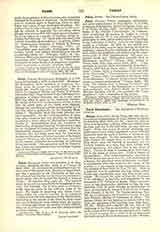

Fabian (FABIANUS), Saint, POPE, 236-250, the extraordinary circumstances of whose election is related by Eusebius (Hist. Eccl., VI, 29). After the death of Anterus he had come to Rome, with some others, from his farm and was in the city when the new election began. While the names of several illustrious and noble persons were being considered, a dove suddenly descended upon the head of Fabian, of whom no one had even thought. To the assembled brethren the sight recalled the Gospel scene of the descent of the Holy Spirit upon the Savior of mankind, and so, divinely inspired, as it were, they chose Fabian with joyous unanimity and placed him in the Chair of Peter. During his reign of fourteen years there was a lull in the storm of persecution. Little is known of his pontificate. The “Liber Pontificalis” says that he divided Rome into seven districts, each supervised by a deacon, and appointed seven sub-deacons, to collect, in conjunction with other notaries, the “acta” of the martyrs, i.e. the reports of the court-proceedings on the occasion of their trials (cf. Eus., VI, 43). There is a tradition that he instituted the four minor orders. Under him considerable work was done in the catacombs. He caused the body of Pope St. Pontianus to be exhumed in Sardinia, and transferred to the catacomb of St. Callistus at Rome. Later accounts, more or less trustworthy, attribute to him the consecration (245) of seven bishops as missionaries to Gaul, among them St. Denys of Paris (Greg. of Tours, Hist. Francor., I, 28, 31). St. Cyprian mentions (Ep., 59) the condemnation by Fabian for heresy of a certain Privatus (Bishop of Lambaesa) in Africa. The famous Origen did not hesitate to defend, before Fabian, the orthodoxy of his teaching (Eus. Hist. Eccl., VI, 34). Fabian died a martyr (January 20, 250) at the beginning of the Decian persecution, and was buried in the Crypt of the Popes in the catacomb of St. Callistus, where in recent times (1850) De Rossi discovered his Greek epitaph (Roma Sotterranea II, 59): “Fabian, bishop and martyr.” The decretals ascribed to him in Pseudo-Isidore are apocryphal.
P. GABRIEL MEIER

